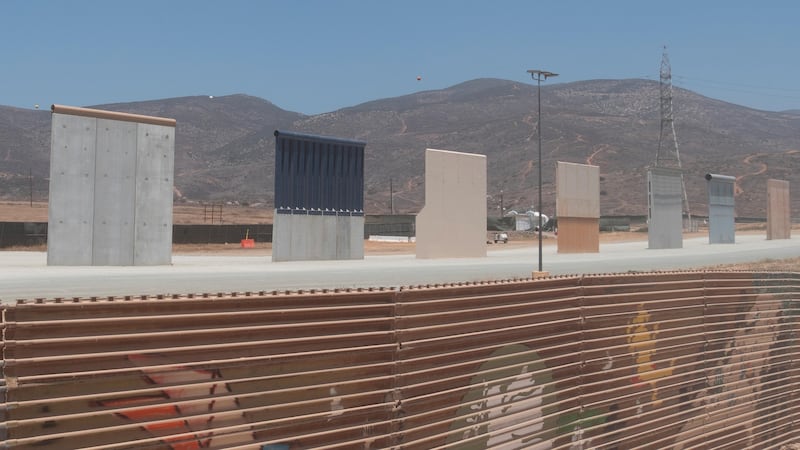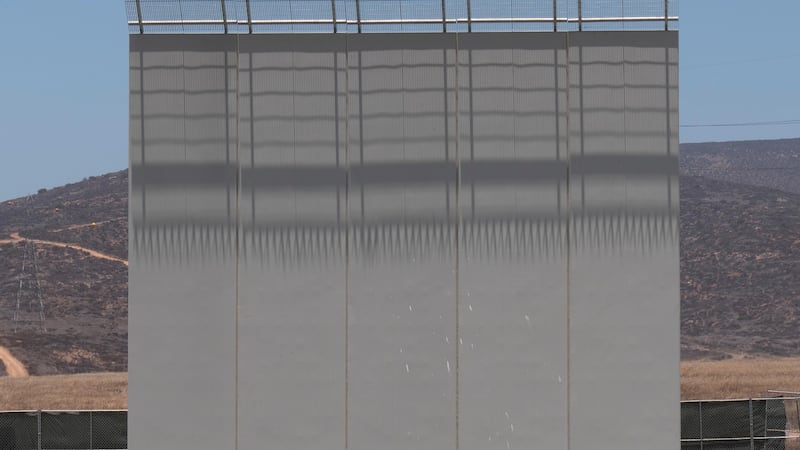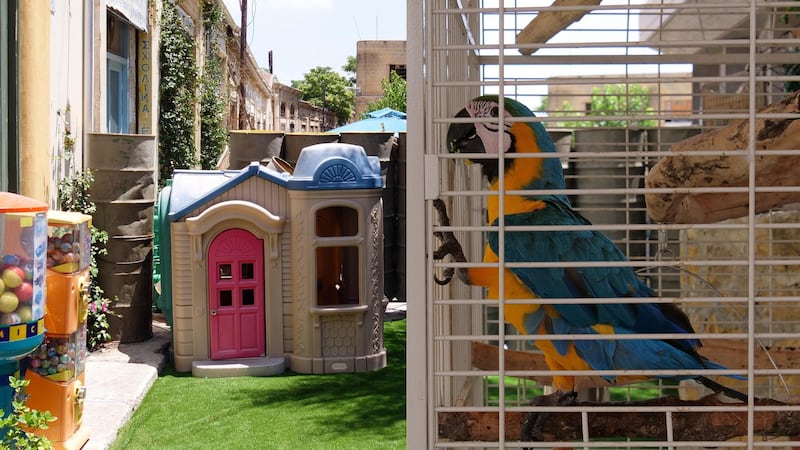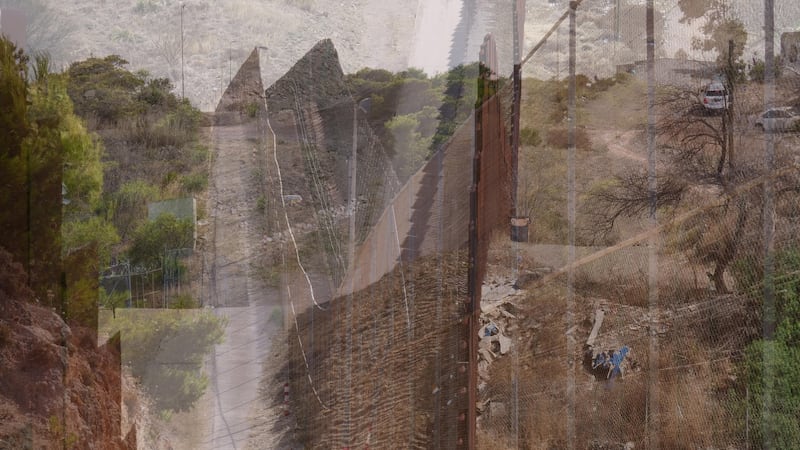"We're going to build a wall," yells Donald Trump, from a succession of campaign pulpits. "A big, beautiful, powerful wall." He's shouting it still, leading his supporters, chanting: "Build That Wall, Build That Wall." The voices are excited, a touch tribal, as if urged by primal feelings.
Despite the fact that there already are vast tracts of fencing along the US / Mexico border, Trump's Wall, as it has come to be known, has reached almost mythic proportions. Now, eight prototypes stand in the California desert, looking like vast pieces of monolithic sculpture. Artist Christoph Büchel, who set up the arts organisation MAGA (Make Art Great Again), is even lobbying to have the prototypes preserved as art.

Why do walls inspire such powerful feelings? Donald Trump is not the only one to be afflicted by mural mania. According to Irish artist, Elaine Byrne, not only are fortified national boundary walls being built around the world, they are also being built at an accelerated rate. In the 20 years between 1978 and 1998, Byrne says 17 border walls were constructed. In the years since 1998, it's more than twice that number. It's all about economics, she says, adding that "although barrier builders tend to be considerably richer than barrier targets, they are not freer or more democratic than target states."
Catalyst for travel
Byrne, who has been researching the wall-building phenomenon for her forthcoming exhibition, Borderline, at the Kevin Kavanagh Gallery, does not believe that Trump's Wall will ever be realised. The erection of the prototypes, however, became the catalyst for her to travel to see them in Mexico, and other national boundaries around the world from Cyprus, to Gibraltar, to Morocco.
Is it ironic that you have to go to Mexico to see the proposed examples of the walls designed to keep the Mexicans out? The US side is fenced off, patrolled and forbidden to civilians, so Byrne went to San Diego, crossed the border at Tijuana, drove along the border, crossing back at Tecate, and through the Sonora desert to Tucson, before going back into Mexico at Nogales. Tijuana provides the best viewing point for the prototypes, and Byrne’s photographs show them, from the rear, in all their sentinel glory.

The Mexican viewing point is pretty low key. "Hard to find," agrees Byrne. She takes out a piece of paper and pencil, and sketches layers of fences, shielding the prototypes on the US side; then, sketches in the current fences, and the desert. Shelley's poem, Ozymandias, comes to mind. There, the poet described the ruins of a huge statue in the midst of a wasteland. "It is like a no-mans land," agrees Byrne. "The US side has lots of nothingness.
“You see that in a lot of places where there are border fences. It’s quite common that the rich country tends to live far away from the border, and the poor right up close. The houses are built right up onto the border on the Mexican side, and there’s nothing as far as the eye can see on the US side. It’s the same I’d say in Melilla – the Moroccan city comes right up to the walls. You could possibly climb up on to the fence from the roofs, but on the Spanish side, there’s a space.”
Tongue in cheek
Büchel’s MAGA has its tongue firmly in its cheek when it calls to pronounce the prototypes as art, but there’s a more profound point at play. Totalitarian regimes, throughout history, have proved adept at aestheticising themselves, whether through military parades, shiny boots and slick uniforms, or great edifices and monuments to themselves. Byrne is clear in her own work that she doesn’t want to give this to the prototypes, so in her exhibition, the main focus are a series of huge close-ups, demonstrating the sheer impenetrability of the walls, balanced by intriguing images, which are layered collages of border walls and fences from her travels. Her own photographs of Trump’s Walls are reproduced in smaller scale, exhibited in a box.
“Look at the image,” she says, when we meet to preview the work. “The blue sky; they’re monuments, and I don’t want to show them like that. If you want to see all eight, you look in the box. People die in these places.” She’s right, but you have to fight the impulse to find the images extraordinary. “You hate to like it,” she agrees. “It’s not about one wall,” Byrne continues. “It’s about an epidemic of wall-building. Trump’s Wall gets all the press, but just look at what Europe’s doing.
"The EU gave money to Spain to build the walls in Ceuta and Melilla, two Spanish cities in Morocco."
Weak spots
Parking the fact that Europe’s colonial past clearly isn’t as in the past as one might like to have thought, these cities have been perceived as weak spots in Europe’s borders. “They wait for sufficient numbers to gather,” says Byrne. “And then they rush the walls. The logic is that if 200 charge, some will get through. A critical mass forms. You only know the ones who don’t make it, that get cut by the razor wire.”

In Ceuta, a Spanish border guard spotted Byrne from his observation hut, and ran down, demanding to see her photographs. “He deleted them, but he didn’t delete them from the camera’s memory,” she laughs, before turning serious again.
“The cost of the Ceuta and Melilla walls were more than the cost of Trump’s walls, if he’s going to build them. But he’s not. The border is already totally fenced, and not just fenced, but patrolled.” Even now, in some areas, old fencing, made from landing mats repurposed from the Vietnam War, is being taken down and replaced with corten steel.

“Trump says that in some places ‘we’ll just have invisible borders’ – which is nonsense. It’s impossible,” concludes Byrne, though I can’t help thinking of the rhetoric surrounding the border on our own island whether invisible, hard, soft or non-existent. Once you have the idea of a border, you open the question of how you demarcate, and then, inevitably, enforce it.
Paradoxically, the more we become globalised, the more, it seems, we want to build walls. This is because, says Byrne, “what we have come to call a globalised world harbours fundamental tensions between opening and barricading.” So we see increasingly liberalised borders on the one hand, coupled with “the devotion of unprecedented energies to border fortification, on the other.”
Creating the illegal
Another paradox of wall-building and capitalism is that boundary walls create the illegal and, therefore, cheap labour that the capitalist system needs to survive. You don’t have a border without having illicit passages through.
Delving deeper, Byrne describes how huge multinational corporations, and the systems within which they operate, end up displacing national legal and political principles with market criteria, demoting the sovereign state. Looked at this way, wall-building is the cry for help from a stricken, dying system, demanding respect through an empty physical gesture.
“It’s something about sovereignty feeling threatened,” agrees Byrne. “A wall’s not going to do it. A wall doesn’t keep out terrorists, biological warfare . . . It’s psychological, the wall-building.”
Empty and psychological as the gesture may ultimately be, border fences and walls do cause harm, as well as injury and death to those who try to cross them illegally. They also create and perpetuate difference, and the us-and-them mentality, which is why, at micro-level, gated communities are such a toxic scourge. Keep people apart, and they become mistrustful.
Byrne describes being on the Mexican side of the border, taking pictures. “The border patrol called down from the US side, and said ‘what are you doing over there? It’s not safe,’ and I was thinking: has he ever even been over here? Most of them haven’t.” In Nogales she found a thriving town, full of life. “I ended up going to a matador’s bar, which I found by accident, right beside the army base. There was far more life there than on the other side.
“Crossing from Melilla into Morocco was more scary,” she continues. There were more hangers on, more gangs of men.” And then in Cyprus, she describes the wall as “so haphazard. In Nicosia, they cut the city in half, and left a no-man’s land. If your house was in that, it’s empty, and exactly as it had been left in the 1970s. Most of the Greek Cypriots I met say they never crossed over, it’s too painful for them.”
The centrepiece of Byrne’s exhibition will be a large Mobius strip-style sculpture. Wire fencing, going on forever: no right side, no wrong side, just an endless, dismayingly beautiful, twisted boundary.
Elaine Byrne, Borderline, is at the Kevin Kavanagh Gallery from September 7 to 29. kevinkavanaghgallery.ie/ elainebyrne.net
Great Walls
Historic walls seem somehow more heroic than today’s constructions.
The Great Wall of China was built between 700BC and the Ming Dynasty era, which ended in 1644. Built to keep invaders out, but also to enable tax collection, the original walls were held together with glutinous rice flour. The official length is 8,851.8km. More than 10 million people visit each year and, despite what they say, you cannot see it from the moon.
Begun in the year 122, Hadrian’s Wall lies within England, but essentially separates what was Roman Britain from what is now Scotland. The original wall would have been almost 120km long, punctuated with milecastle forts to allow the passage of people and goods, and to collect tariffs. Soldiers from all over the Roman Empire were stationed there, including from as far afield as Syria. Brexiteers who want fresh borders take note.
Built, or rather, planted in the 1800s, The Great Hedge of India was an almost 1,000km line of thick and thorny hedging along the inland customs line, created by the British to impose a highly lucrative salt tax on parts of India. Maintaining the hedge was no easy task and when the project was abandoned, it disappeared entirely. You can trace parts of its route today in the highways built over its path.











